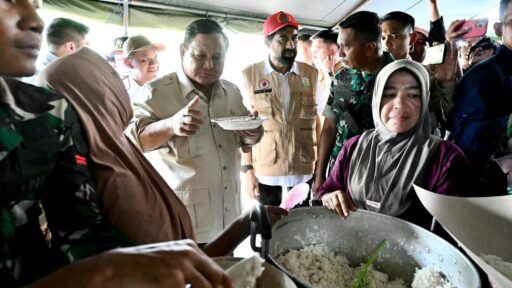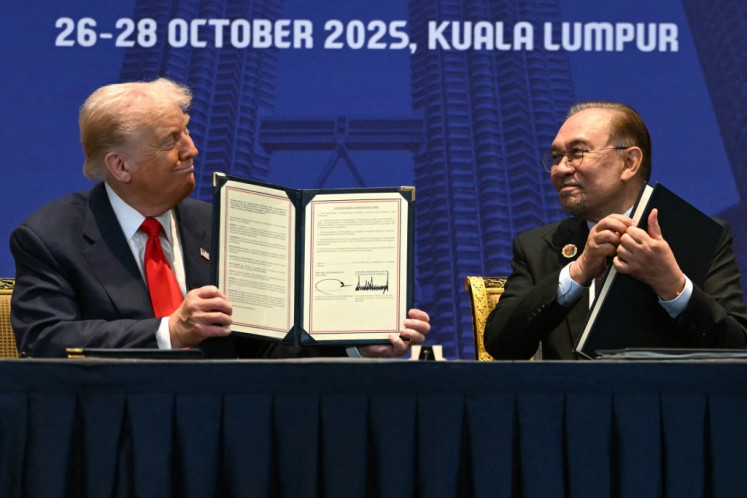Popular Reads
Top Results
Can't find what you're looking for?
View all search resultsPopular Reads
Top Results
Can't find what you're looking for?
View all search resultsNoel Trustrum: Getting the Big C in focus
Family portrait on top of crushed cars after the tsunami in Aceh
Change text size
Gift Premium Articles
to Anyone
 Family portrait on top of crushed cars after the tsunami in Aceh. (Courtesy of Noel Trustrum)" border="0" height="261" width="512">Family portrait on top of crushed cars after the tsunami in Aceh. (Courtesy of Noel Trustrum)
Family portrait on top of crushed cars after the tsunami in Aceh. (Courtesy of Noel Trustrum)" border="0" height="261" width="512">Family portrait on top of crushed cars after the tsunami in Aceh. (Courtesy of Noel Trustrum)Cancer is a word â itâs not a sentence, say survivors, who know that the vile disease can be beaten. All thatâs needed is the right treatment, limitless support layered with luck â and a positive attitude.
Taking on a major task like producing a book ahead of the 10th anniversary of the 2004 Boxing Day tsunami also helps.
âPublishing requires a huge amount of energy,â said New Zealand geomorphologist Noel Trustrum as he red-inked text corrections and sorted page proofs in his hometown of Wellington. Heâd just returned from another 10-day high-tech radiation treatment in Auckland, 650 kilometers away.
âBut this has kept me going. Iâve had no time to think about my cancer.â
Thereâs another factor at play in his book project: every page tells a story of resilience, of courage in crises and the determination to look ahead; the bigger picture shrinks individual problems.
Aceh Revives â Celebrating 10 years of Recovery in Aceh is an account of what has happened in the decade since the worldâs third-largest recorded earthquake struck off the west coast of Sumatra, rattling the ocean floor and triggering a huge tsunami.
At least 230,000 people perished when the wall of water, which was up to 30 meters high, smashed through coastal communities in several Indian Ocean countries. Aceh was the hardest hit, with 170,000 people killed and some 500,000 of the provinceâs 4.5 million people left homeless, jobless and landless.
 A woman collects water from the only functioning pipe. (Courtesy of Noel Trustrum)
A woman collects water from the only functioning pipe. (Courtesy of Noel Trustrum)
The capital city of Banda Aceh was also battered. In the book, Imam Munandar recalls âa large black blanket creeping over the landâ and his desperate, yet ultimately unsuccessful search for members of his family.
Five weeks after the disaster, Trustrum arrived on an assignment from New Zealand Aid Programme to report on long-term needs. The small South Pacific nation had already provided emergency support and now wanted to help prevent further tragedies.
Heâd been an intermittent visitor to Indonesia on watershed management aid projects since 1988, but was unprepared for the âsensory overloadâ he encountered in early 2005.
âI soon became overwhelmed by the full force of sights, sounds and smells,â he wrote. âIt felt surreal to the point that I found myself being desensitized to the reality of the situation.â
Geomorphologists, or âskin of the earth scientistsâ, are multi-disciplinary scientists who study landforms and the forces that shape them.
 Family portrait on top of crushed cars after the tsunami in Aceh. (Courtesy of Noel Trustrum)<)
Family portrait on top of crushed cars after the tsunami in Aceh. (Courtesy of Noel Trustrum)<)
Family portrait on top of crushed cars after the tsunami in Aceh. (Courtesy of Noel Trustrum)
Cancer is a word ' it's not a sentence, say survivors, who know that the vile disease can be beaten. All that's needed is the right treatment, limitless support layered with luck ' and a positive attitude.
Taking on a major task like producing a book ahead of the 10th anniversary of the 2004 Boxing Day tsunami also helps.
'Publishing requires a huge amount of energy,' said New Zealand geomorphologist Noel Trustrum as he red-inked text corrections and sorted page proofs in his hometown of Wellington. He'd just returned from another 10-day high-tech radiation treatment in Auckland, 650 kilometers away.
'But this has kept me going. I've had no time to think about my cancer.'
There's another factor at play in his book project: every page tells a story of resilience, of courage in crises and the determination to look ahead; the bigger picture shrinks individual problems.
Aceh Revives ' Celebrating 10 years of Recovery in Aceh is an account of what has happened in the decade since the world's third-largest recorded earthquake struck off the west coast of Sumatra, rattling the ocean floor and triggering a huge tsunami.
At least 230,000 people perished when the wall of water, which was up to 30 meters high, smashed through coastal communities in several Indian Ocean countries. Aceh was the hardest hit, with 170,000 people killed and some 500,000 of the province's 4.5 million people left homeless, jobless and landless.
A woman collects water from the only functioning pipe. (Courtesy of Noel Trustrum)
The capital city of Banda Aceh was also battered. In the book, Imam Munandar recalls 'a large black blanket creeping over the land' and his desperate, yet ultimately unsuccessful search for members of his family.
Five weeks after the disaster, Trustrum arrived on an assignment from New Zealand Aid Programme to report on long-term needs. The small South Pacific nation had already provided emergency support and now wanted to help prevent further tragedies.
He'd been an intermittent visitor to Indonesia on watershed management aid projects since 1988, but was unprepared for the 'sensory overload' he encountered in early 2005.
'I soon became overwhelmed by the full force of sights, sounds and smells,' he wrote. 'It felt surreal to the point that I found myself being desensitized to the reality of the situation.'
Geomorphologists, or 'skin of the earth scientists', are multi-disciplinary scientists who study landforms and the forces that shape them.
Noel Trustrum (JP/Duncan Graham)
Trustrum, who'd originally trained as a geologist, was selected because of his more than than 30 year's experience in Europe, Japan, Vietnam and Pacific Islands.
In Aceh, he met conservationist Mike Griffiths, another Kiwi and long-term Indonesian resident. Griffiths had established the Leuser International Foundation in 1994 to protect the ecosystem around the 3,404-m high Leuser Mountain.
Griffiths knew his way around and had the right contacts. By the time Trustrum returned to his Wellington, where he worked as a senior development specialist with government-owned company, GNS Science, he already had the makings of a reforestation project to stabilize the land and provide security for farmers.
He also had gigabytes of photos, for he is a keen landscape photographer, a fascination he developed during his teenage years using his father's darkroom.
The photos showing the devastation led to a small book called Scars: Life after the Tsunami.
He'd kept the camera lens focused mainly on the torn townscapes and the ripped lands rather than the numbed and battered people struggling to understand what had happened.
Three years later he organized a workshop on disaster-risk management in Jakarta to celebrate 50 years of NZ-Indonesia diplomatic relations. Attendees included Indonesia's famous Dr Fixit, Kuntoro Mangkusubroto, then director of the Rehabilitation and Reconstruction Executing Agency for Aceh and Nias (BPRR), and now the head of the President's Delivery Unit. He suggested Trustrum's photos be published to commemorate the disaster.
Then fate intervened with a rare liver cancer. Trustum underwent a major operation that went wrong. Doctors reckoned he'd last six months. 'But they didn't know Noel,' said his wife Helen. 'He's determined.'
He recovered, but this year the disease reappeared ' hence the radiation treatments.
Despite these traumatic events, he was determined to revisit Aceh in case the cancer made it impossible to travel in the future.
With the help of translator Kadek Krishna Adidharma and photographer Udo von Mulert, he set out to record 'inspirational stories' and re-shoot the scenes he recorded in 2005.
Supported by NZ Ambassador David Taylor, Trustrum mustered eight corporate sponsors together to back the 218-page book, which includes poetry from people like award-winning Bali midwife Robin Lim, who also rushed to help in Aceh.
Aceh Revives, published by Saritaksu Editions in Bali (run by another New Zealander, Sarita Newson), will be launched at the Ubud Writers & Readers Festival in early October and then in Jakarta at the NZ embassy.
'Rehabilitation is still a work in progress, but overall it's pretty amazing,' Trustrum said. 'There's now very little evidence of broken buildings, though the fear remains.'
'There's also a huge need for a better evacuation strategy. In April 2012 there was another big quake; gridlock followed as people trying to get to higher ground were running into those seeking to reach the 'escape buildings' that were built closer to the sea.
'It's been a fulfilling exercise to discover the powerful untold stories of recovery that demonstrate the ability of the human spirit to endure, recover and rebuild,' Trustum said. 'This isn't just about Indonesia. It's about what happened, how people coped, what's going on now and the lessons learned ' this is of international importance.'
'The resilience of the Acehnese people has inspired me to move beyond my own personal struggle for good health.'










